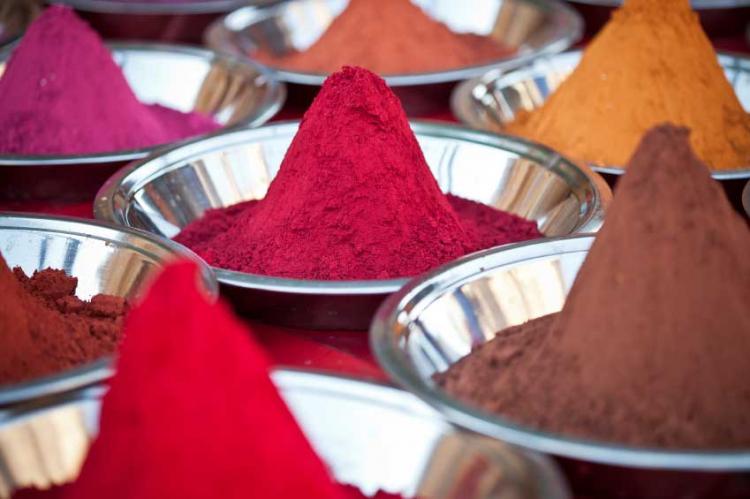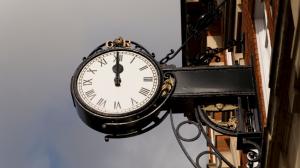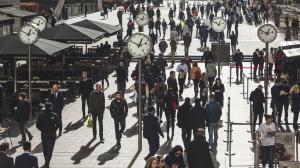
Best Comet of 2025?
C/2024 G3 (ATLAS) has already become very faintly visible to the naked eye for observers in the Southern Hemisphere.
Holi (Dolyatra, Doul Jatra, Basanta-Utsav) is the Hindu festival colors that celebrates the triumph of good over evil, good harvest, and fertility. It usually falls in the later part of February or March.

Holi is a time when everyone throws off the gloom of winter and rejoices in the colors and liveliness of spring.
©iStockphoto.com/traveler1116
Holi is celebrated over two days in many areas, while other areas may celebrate it for longer periods. The festival loosens the normal social restrictions by bringing people together not based on sex, status, and/or age. A public bonfire is usually held between 10pm and midnight to commemorate the burning of Holika on the first evening of Holi. Many sing and dance in the street while other are shouting, cursing and causing general mayhem during the bonfire event.
Millions of Hindus around the world celebrate Holi with a community festival. Many visit each other’s homes to distribute sweets and greet each other. Men, women, adult and children all take part in dances and other cultural programs during Holi. People dress in pure white and gather together in a common place to color each other with gulal, which are colored powders and other form of dyes. A popular activity is the throwing of water balloons at one another, sometimes called lola.
Holi is a restricted holiday in India, so government offices and most businesses remain open. Individuals have the flexibility to take time off to celebrate the holiday if they choose. It is not a nationwide public holiday in countries such as Australia, Canada, the United Kingdom, and the United States but some cities may hold large celebrations for the occasion.
Holi was first celebrated as an agricultural festival celebrating the arrival of spring but has now evolved into a time when everyone throws off the gloom of winter and rejoices in the colors and liveliness of spring. The day observes the various events in Hindu mythology and disregards the social norms by participating in the festivities.
Holi is accompanied by many legends but there are two stories that serve as the origin of Holi traditions. The story of Krishna and Radha is said to be the basis for the ritual of throwing and applying colored water and powder. According to legend, the young Krishna complained to his mother, Yashoda that Radha was so fair and he was so dark. Yashoda advised him to apply color to Radha’s face and see how her complexion would change. Thus, Holi is now become a festival of colors not only to celebrate the coming of spring but also to disregard social norms and to focus on enjoying the festivities.
Another legend behind Holi is that an evil king tried to kill his son, Prahalada, a devoted follower of the god Vishnu. The king, Hiranyakashipu, challenged Prahalada to sit on a pyre and asked (though some believed she was forced) his sister, Holika, who the king believed was immune to fire, to sit with his son in the fire. When the fire started, everyone watched as Holika burned to death, but Prahalada survived without any injuries due to his devotion to Vishnu. According to some accounts, Holika begged Prahalada for forgiveness before her death, so he promised that the burning of Holika would be remembered every year at Holi.
The bonfire represents the burning of Holika, the triumph of good over evil. All of the dead leaves, twigs and dirt that is collected during the winter month, is thrown into the fire to symbolize the evil spirits. The ashes from the bonfire are believed to provide protection against diseases. Different colored powder or gulal, oils and water represent the arrival of spring and its vibrant colors.
Note: It is not possible to mention every activity that takes place on this occasion as celebrations vary in different regions. However, this article provides a general overview of the main celebrations that usually occur during this event. Moreover, the date in which it is celebrated may vary depending on locations and calendar interpretations.

C/2024 G3 (ATLAS) has already become very faintly visible to the naked eye for observers in the Southern Hemisphere.

How does the 12-hour clock system work? Is midnight 12 am or 12 pm?

Why do many countries set the clocks back and forth an hour twice a year?

Why are there 12 months? How long are they, and what do the month names mean?